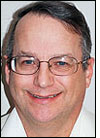Five years ago, Oregon Health & Science University (OHSU) Healthcare was among the early adopters of radio frequency identification, using Wi-Fi-based tags to track assets around its facilities. The organization—which operates OHSU Hospital and OHSU Doernbecher Children’s Hospital at its Marquam Hill Campus, in Portland—already had a Cisco Unified wireless network in place when it selected a tracking solution from AeroScout, with RFID tags that would speak to its existing Cisco nodes.
The hospital is more than just an early RFID adopter, says Joel Cook, AeroScout’s health-care solutions marketing director. “It takes a methodical approach to adoption,” Cook states, and OHSU continues to evolve as it adopts technology at a measured pace. Beginning with several hundred items—mostly infusion pumps—the hospital ensured that the system worked, and then began gradually adding more tags to such items as specialty beds and wheelchairs. The facility has tagged 2,500 mobile assets to date, and expects to have tagged another 1,000 such items by the end of this year.
From the onset, the hospital aimed to reduce the time staff members spent seeking equipment at its Portland facilities, says Dennis Minsent, OHSU’s director of clinical technology services. The AeroScout Wi-Fi T2 tags transmit a unique ID number to the medical center’s existing Cisco Wi-Fi nodes, which forward that ID to AeroScout’s MobileView software, residing on the hospital’s back-end system, where the tag’s location is pinpointed on a map of OHSU’s nine buildings, which range from five to 14 stories in height. Nurses using the system were able to reduce the time they spent walking the floor in search of equipment.
After five years of utilizing the technology throughout its nine-building campus, Minsent says he doesn’t measure the system’s success in terms of numbers. It was not a return on investment he was watching for, he notes, but rather greater one-on-one time between patients and nurses.
Initially, the system was installed to track the locations of assets across OHSU’s nine buildings, which comprise a total of 1,091,211 square feet. But shortly after that installation, the hospital began installing AeroScout T5 sensor tags within its coolers—both refrigerators and freezers—to track the temperatures of the units that stored pharmaceuticals, lab specimens, breast milk and food. “We needed a system to easily document and track temperatures,” Minsent says, “as well as comply with regulatory issues.”
The hospital employs the MobileView software system to store a record of the temperatures of 225 cooling units throughout its buildings, as well as receive an alert whenever a refrigerator or freezer temperature exceeds an acceptable threshold. OHSU intends to install T5 sensor tags on 200 additional coolers by the end of 2010.
In recent weeks, the hospital has been adding new features to the MobileView software, including a “favorites” option that lets employees indicate, on a drop-down menu, the items they most often search for. OHSU also plans to link the MobileView software with a Lightweight Directory Access Protocol (LDAP) that would allow workers to utilize the same user name and password for MobileView or other systems in the hospital database.
“Staff really appreciate being able to go right to the device they’re looking for,” Minsent states. “It saves a great deal of time, as opposed to looking from floor to floor, and closet to closet, to find a device to treat their patients.”
Next, the hospital intends to employ MobileView for workflow analysis. This could mean tagging mobile X-ray machines and X-ray image intensifiers (C-arms). The tags would transmit their ID numbers to the facility’s back-end system, where MobileView would then identify each machine’s location, as well as how often each is being used and for how long, thereby providing a better understanding of workflow within OHSU’s radiology department. “The goal is to help clinicians become more efficient,” says Steffan Haithcox, AeroScout’s marketing senior director.
In addition, the hospital intends to begin providing tags to some of its patients—initially, those in its head-trauma unit—to enable hospital staff members to receive an alert if a patient leaves a specific area, and to make it easier to locate anyone within the building.


